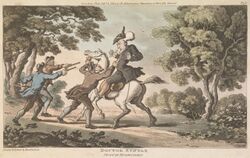Villain (nonfiction): Difference between revisions
Jump to navigation
Jump to search
No edit summary |
No edit summary |
||
| Line 1: | Line 1: | ||
[[File: | [[File:Ernst_von_Possart_as_Mephistopheles.jpg|thumb|Ernst von Possart as Mephistopheles (no later than 1904).]]A '''villain''' (also known as the "antagonist," "baddie", "bad guy", "heavy" or "black hat") is an "evil" character in a story, whether a historical narrative or, especially, a work of fiction. | ||
== Description == | == Description == | ||
| Line 12: | Line 12: | ||
== Nonfiction cross-reference == | == Nonfiction cross-reference == | ||
[[File:Dr._Syntax_stopped_by_highwaymen_Engraving.jpg|thumb|250px|''Doctor Syntax and Highwaymen'', 1813 - Engraving by Thomas Rowlandson. "Doctor Syntax" – a popular literary character of the early nineteenth century – on horseback, stopped by three robbers armed with pistols.]] | |||
* [[Criminal (nonfiction)]] | * [[Criminal (nonfiction)]] | ||
* [[Supervillain (nonfiction)]] | * [[Supervillain (nonfiction)]] | ||
Revision as of 18:56, 6 June 2016
A villain (also known as the "antagonist," "baddie", "bad guy", "heavy" or "black hat") is an "evil" character in a story, whether a historical narrative or, especially, a work of fiction.
Description
The villain usually is the antagonist (though can be the protagonist), the character who tends to have a negative effect on other characters.
A female villain is occasionally called a villainess (often to differentiate her from a male villain).
Random House Unabridged Dictionary defines villain as:
A cruelly malicious person who is involved in or devoted to wickedness or crime; scoundrel; or a character in a play, novel, or the like, who constitutes an important evil agency in the plot".

